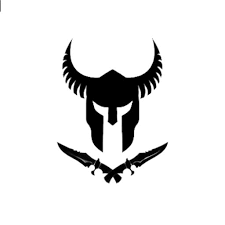In this article, we’ll delve deeply into the history and use of Viking runes, an ancient writing system used by Vikings and Germanic people. We’ll explore their symbolic and spiritual meanings, their use in divination, and their influence on current popular culture. Viking runes continue to captivate many people due to their mystique and symbolic power, and we’re excited to share more about this fascinating practice.
Summary
ToggleOrigins and History of Viking Runes
Viking runes are a writing system developed by Germanic people over 2,000 years ago, evolving with new forms and symbols over time. The Vikings used these runes to carve messages, poems, and even for magic and divination. This system includes 24 symbols, each representing a letter, sound, and symbolic meaning. Runes remained in use even after the Christianization of Scandinavian and Germanic regions and are still studied and used in modern spiritual and magical practices.

General Meaning of Viking Runes
Viking runes are both a writing system and a divination tool that ancient Scandinavians used for communication, predicting the future, and performing magic. Each rune has a symbolic meaning that can vary depending on the context in which it’s used. Beyond their original use, Viking runes have also become popular in contemporary culture, including fashion, tattoos, music, films, and modern spiritual and occult practices.
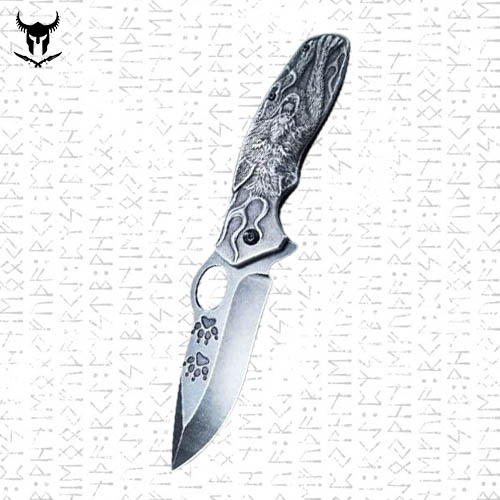
Viking Folding Knife Wolf Geri – Your Adventure Companion
- Designed to withstand the harshest conditions.
- An essential tool for all your adventures.
- A unique and original design.
- Its folding format makes it compact and discreet.
However, it’s essential to remember that Viking runes are a cultural and spiritual heritage for Nordic and Germanic people. Appropriating or commercializing these symbols insensitively may be offensive or disrespectful to communities that regard them as sacred. It’s important to learn about the history and cultural significance of Viking runes before using them for personal or commercial purposes.
How Were Viking Runes Used in Nordic Culture ?
Viking runes served several purposes in Nordic culture. They functioned as a writing system for communicating important messages, a divination practice for interpreting results, a means of infusing objects with magical power, and were used in religious rituals to invoke the Norse gods or seek their protection. Runes were also used to mark personal items, weapons, and tombstones, serving as a form of communication, divination, magic, religious ritual, and a marker of identity in Viking culture.
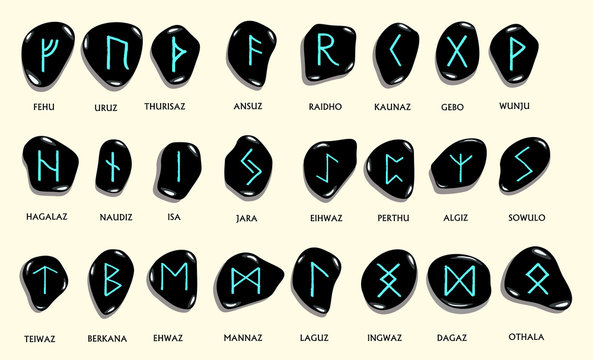
The 24 Names of Viking Runes and Their Meanings
The Nordic runes form a writing system used by Germanic and Scandinavian people before the adoption of the Latin alphabet. There are 24 runes in the common runic alphabet, known as the Elder Futhark. Here are the names and meanings of the runes in traditional order:
- Fehu (F): Represents material wealth and symbolizes livestock, abundance, and prosperity.
- Uruz (U): Symbolizes life force, raw energy, and vitality. Associated with physical strength, courage, and inner power.
- Thurisaz (Th): Represents danger and destructive forces, linked to protection and repelling threats.
- Ansuz (A): Associated with communication, inspiration, and wisdom; the ability to convey messages and receive divine guidance.
- Raido (R): Symbolizes travel, movement, and change, representing both physical journeys and spiritual transitions.
- Kenaz (K): Linked to knowledge, enlightenment, and transformation; symbolizes truth-seeking and personal growth.
- Gebo (G): Represents gifts, exchange, and harmonious relationships, symbolizing the balance between giving and receiving.
- Wunjo (W): Symbolizes joy, happiness, and personal fulfillment, representing harmony, satisfaction, and inner contentment.
- Hagalaz (H): Associated with destruction, chaos, and transformation, symbolizing trials, radical changes, and rebirth after adversity.
- Nauthiz (N): Represents needs, constraints, and challenges, symbolizing patience, perseverance, and resilience.
- Isa (I): Symbolizes ice, stillness, and blockages, representing periods of stagnation and the need for patience.
- Jera (J): Linked to harvest, cycles, and growth, symbolizing the rewards of hard work and positive outcomes.
- Eihwaz (Ei): Represents transformation, endurance, and rebirth, symbolizing adaptability and regeneration.
- Perthro (P): Symbolizes fate, chance, and hidden mysteries, associated with divination, luck, and emerging opportunities.
- Algiz (Z): Represents protection, defense, and spiritual connection, symbolizing a higher force, self-confidence, and security.
- Sowilo (S): Associated with victory, light, and clarity.
- Tiwaz (T): Symbolizes justice, honor, and willpower, representing truth, integrity, and ethical decision-making, connected to the Norse god Tyr.
- Berkano (B): Linked to growth, fertility, and maternal protection, symbolizing renewal, motherhood, and healing.
- Ehwaz (E): Represents movement, partnership, and harmony, symbolizing collaboration, mutual trust, and spiritual journey.
- Mannaz (M): Associated with humanity, self-awareness, and community, symbolizing intelligence, cooperation, and social relationships.
- Laguz (L): Symbolizes water, intuition, and emotions, representing fluidity, creativity, and emotional connection.
- Ingwaz (Ing): Linked to fertility, achievement, and completion, symbolizing the end of a cycle and new beginnings.
- Othala (O): Associated with heritage, property, and tradition, symbolizing roots, family, and a sense of belonging.
- Dagaz (D): Represents light, transformation, and clarity, symbolizing dawn, spiritual renewal, and self-realization.
Note that rune meanings may vary slightly based on different traditions and interpretations.
Different Categories of Nordic Runes
Il existe plusieurs façons de catégoriser les runes vikings, mais voici quelques-unes des catégories les plus courantes :
There are several ways to categorize Viking runes, including:
Communication Runes: Associated with communication, eloquence, and inspiration, used to enhance oratory skills, aid message transmission, and foster creative inspiration. Ansuz symbolizes communication and divine inspiration, while Gebo represents exchange and harmonious relationships.
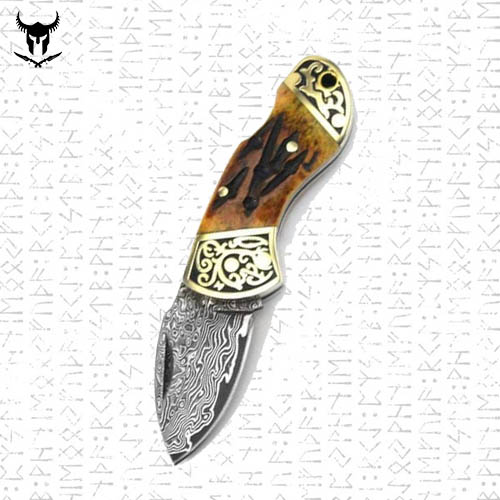
Folding Nordic Damascus Steel Knife with Hand-Carved Pure Brass Handle
- Folding Quality Damascus Steel Knife
- Sharp 4.0 cm Blade
- Hand-Carved Brown Ox Bone Handle with Pure Brass Seashell Inlays
- Damas Texture Pattern on the Blade
Elder Futhark Runes: Primarily used for writing but also possessing symbolic meanings associated with concepts like wealth, strength, communication, travel, protection, transformation, and fate.
Divinatory Runes: Used for divination and oracle reading. Each rune had specific meanings when drawn, providing answers and guidance. For instance, Fehu could represent wealth, Uruz strength and vitality, and Raido movement and travel.
Protective Runes: Used to ward off harmful influences, often engraved or worn as amulets and talismans. Common protective runes include Algiz (defense and spiritual connection) and Thurisaz (protection from threats and obstacles).
Healing Runes: Associated with health and well-being, used in healing practices to promote recovery and balance. Sowilo symbolizes light and healing energy, while Berkano is linked to fertility and regeneration.
Power Runes: Used to amplify and channel personal power, often engraved or drawn during rituals or meditations to strengthen abilities and willpower. Common power runes include Uruz (inner strength) and Mannaz (intelligence and cooperation).
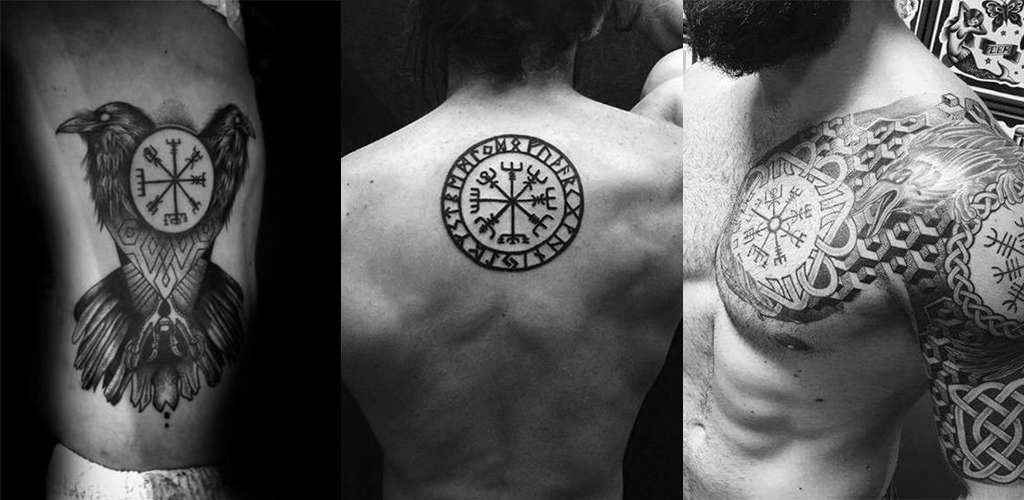
Signification de tatouage rune viking :
The Vikings used rune tattoos to express their culture, beliefs, and heritage. These tattoos often represented strength, courage, loyalty, honoring the Norse gods, and cultural identity. They also marked war achievements, clan or tribe membership, and were believed to have magical powers for protection and enhancing strength, agility, wisdom, and intelligence.
